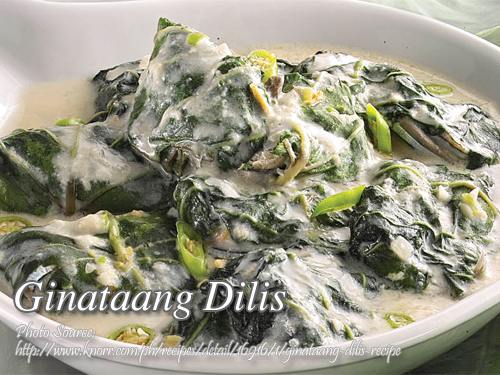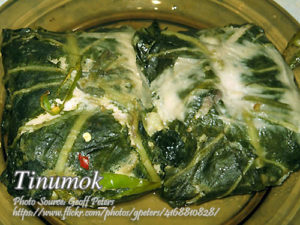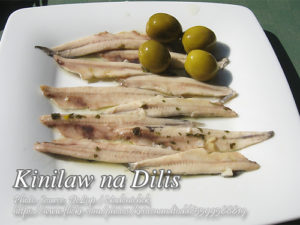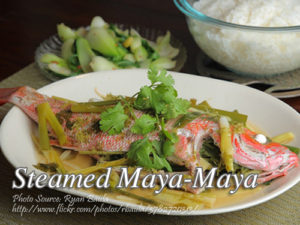This ginataang dilis recipe is made by wrapping the fresh anchovies in taro root leaves (gabi leaves) then simmered in a mixture of coconut milk, spices and seasonings. This dish is great as viand accompanied with steamed rice or served with other dishes like grilled meat, fish or seafoods.
Ginataang Dilis: A Comforting Taste of Home
There’s something about the smell of coconut milk simmering on the stove that takes me back to my childhood in Quezon. My Tita Linda, who was known in our family for her delicious home-cooked meals, would make ginataang dilis every time we had fresh anchovies from the market. She would gather us in the kitchen, assigning tasks—my cousin Rodel would wash the fish, while I carefully helped wrap them in gabi leaves, a task I learned to love over time.
The Secret to a Perfect Ginataang Dilis
One of the things my uncle Mang Ben always emphasized was the importance of fresh ingredients. The fresher the dilis, the sweeter and more flavorful the dish would be. Cleaning the fish was the first step—removing the heads and making sure they were properly drained ensured that the coconut milk wouldn’t turn bitter.
Tita Linda always said that the key to a rich, velvety sauce was to use both thin and thick coconut milk. The first batch, extracted with more water, allows the fish to slowly cook and absorb the flavors, while the second, thicker one is added later to create a creamy finish. And let’s not forget the spices! Onion, garlic, ginger, and green chili bring a depth of flavor that balances the richness of the coconut milk.
Why Wrapping in Gabi Leaves Makes a Difference
Unlike other versions of ginataang isda, this particular recipe calls for gabi leaves to wrap the anchovies. I used to wonder why Tita Linda insisted on this extra step, but I realized that the leaves lock in moisture, keeping the fish tender and absorbing all the creamy, savory goodness of the sauce. Not only does it enhance the flavor, but it also adds a slightly earthy, aromatic note that makes the dish distinct.
Wrapping the fish in gabi leaves takes patience, but it’s a rewarding process. You form small rectangular packets, securing them with a string to keep everything intact. Once wrapped, they’re arranged neatly in the pot, waiting to be bathed in the first round of coconut milk.
Slow Simmering for Maximum Flavor
Patience is key when cooking ginataang dilis. Once the fish packets are arranged, thin coconut milk is poured in, and the mixture is left to simmer. The gentle heat allows the flavors to meld, creating a harmonious balance between the fish, spices, and creamy sauce. When the coconut milk is reduced by half, thick coconut cream is added, resulting in a rich, luxurious consistency.
One sign that the dish is ready is when the coconut oil begins to separate from the sauce. This means the flavors have fully developed, and the fish has absorbed all the delicious coconut and spice-infused goodness. At this point, the smell alone is enough to make anyone’s stomach rumble.
A Dish Best Enjoyed with Rice and Family
When I think of comfort food, ginataang dilis is one of the first dishes that comes to mind. The first bite always brings a flood of memories—the slight heat from the chili, the creamy coconut sauce coating the tender fish, and the unmistakable aroma of gabi leaves. This dish is best enjoyed with a steaming plate of rice, where the sauce can be drizzled generously over the grains, soaking up all the flavors.
I remember how my Lola Rosa would always insist on having this dish alongside grilled tilapia or charcoal-roasted eggplant for a perfect balance of smoky and creamy flavors. It was a staple during family gatherings, where everyone sat around the table, sharing stories while savoring each bite.
The History and Cultural Significance of Ginataang Dilis
Dishes cooked in gata (coconut milk) are deeply rooted in Filipino cuisine, especially in Bicol, Quezon, and other coconut-rich provinces. Coconut milk has been a primary ingredient in many regional specialties, passed down through generations. This method of cooking not only enhances flavors but also serves as a natural preservative, allowing dishes to last longer in the tropical heat.
In the old days, before refrigeration was common, wrapping fish in gabi leaves was a way to keep the meat tender and prevent it from drying out. This technique has been preserved and is still widely used in traditional Filipino kitchens today.
Bringing a Taste of Tradition to Your Own Kitchen
Cooking ginataang dilis at home is more than just preparing a meal—it’s about keeping traditions alive. Whether you grew up eating this dish or are trying it for the first time, the process itself is rewarding. The gentle simmering, the fragrant coconut aroma filling your kitchen, and the first taste of its creamy, savory goodness make all the effort worth it.
So the next time you visit the market and see fresh dilis, take a little inspiration from Tita Linda, Mang Ben, and Lola Rosa. Gather your ingredients, wrap them with care, and let the magic of coconut milk do its work. Who knows? You might just start a new tradition of your own.
How to Cook Ginataang Dilis (Anchovies in Coconut Milk)
Ingredients
- 1/2 kilo fresh small anchovies dilis
- 1 & 1/2 cups grated young coconut
- 1 pc medium sized onion minced
- 1 tsp. MSG or vetsin
- 3 cloves minced garlic
- 1 Tbsp. ginger minced
- 4 pcs green finger chili pepper siling haba
- 2 Tbsp. salt
- 6 pcs large wilted taro root leaves or gabi leaves
- 1 cup thick coconut milk 1st extract
- 1 cup thin coconut milk 2nd extract
Instructions
How to cook Ginataang Dilis
- Cut off dilis head. Wash and drain. Combine dilis, grated young coconut, onion, garlic, ginger and green pepper (mince or slice pepper if you want it a hot and spicy dish).
- Season with salt and MSG.
- Wrap 2-3 tablespoons mixture in gabi leaves. Form into squares or rectangles. Tie with a string.
- Arrange wrapped mixture in a pan, pour in thin coconut milk.
- Cover and let boil for a while then lower heat and simmer until cream is reduced into half.
- Add the thick coconut milk. Simmer again until thickens and oil comes out.
- Then, it is ready to serve.
Notes
Cooking Tips:
Use Fresh Dilis for the Best Flavor
Fresh anchovies make a huge difference in taste and texture, giving the dish a naturally sweet and briny flavor. Always clean the fish thoroughly by removing the heads and draining well to prevent the coconut milk from turning bitter. If fresh anchovies aren't available, opt for high-quality frozen ones and thaw them properly before cooking.Wrap the Fish Tightly in Gabi Leaves
Securely wrapping the anchovies in gabi leaves helps lock in moisture, keeping the fish tender while infusing a subtle earthy aroma. Make sure the leaves are pliable by briefly passing them over an open flame or soaking them in warm water to prevent tearing. Tightly tying the packets with kitchen string ensures they hold their shape while simmering in the coconut milk.Simmer Slowly for a Creamy and Rich Sauce
Cooking ginataang dilis over low heat allows the fish to absorb the flavors of the coconut milk, spices, and gabi leaves fully. Start with thin coconut milk to let the flavors meld before adding the thick cream, which creates a luscious, velvety sauce. Letting the dish cook until the coconut oil naturally separates enhances both the texture and taste, making every bite irresistibly creamy.





